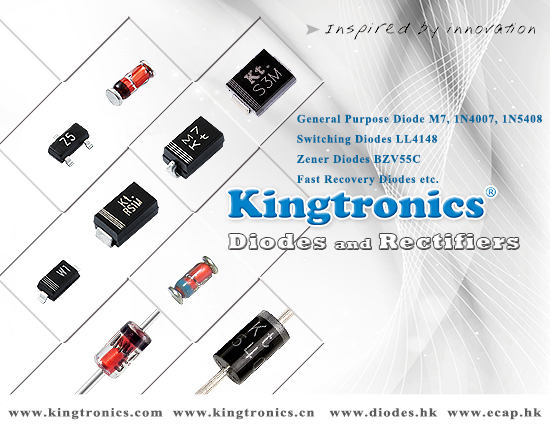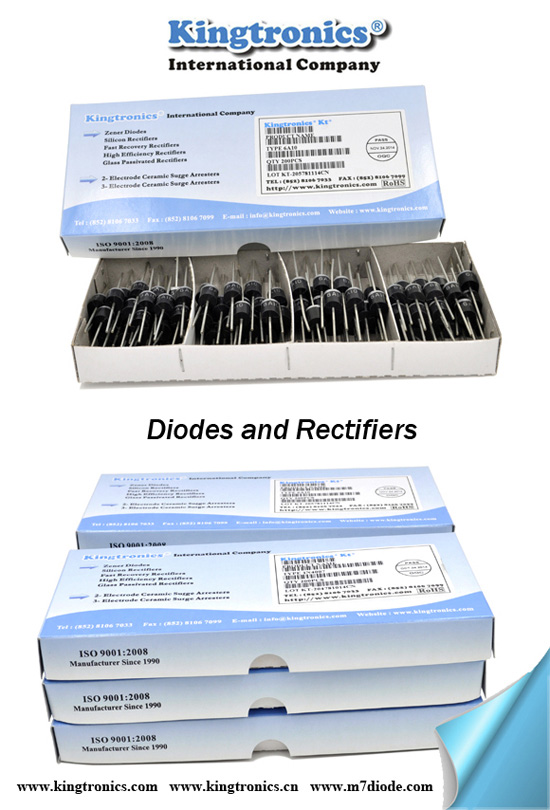Kingtronics Introduction of Diodes
22 Apr 2024Diode is a dual electrode electronic component with asymmetric conductivity. When conducting forward, there is an infinitesimal resistance between its two electrodes (anode and cathode), while in reverse, there is an infinitesimal resistance, meaning that current is only allowed to flow through the diode in a single direction.
In 1874, German physicist Karl Braun discovered the rectification ability of crystals. Therefore, the first generation diode developed in 1906, the "cat whisker diode," was made from mineral crystals such as galena. Early diodes also included vacuum tubes, which had two electrodes, an anode, and a thermal cathode. After the discovery of semiconductor performance, diodes became the world's first semiconductor device. Nowadays, most diodes are produced using silicon, and other semiconductor materials such as selenium or germanium are sometimes also used. The most common structure currently is a semiconductor performance junction chip connected to two electrical terminals through a PN junction.
Function
A diode has two terminals, anode and cathode, and current can only flow in a single direction. That is to say, current can flow from the anode to the cathode, but not from the cathode to the anode. The application of the unidirectional characteristic possessed by diodes is commonly referred to as the "rectification" function. In a vacuum tube, the voltage applied between the electrodes can allow hot electrons to travel from the cathode to the anode, thus having a rectifying effect. The conversion of alternating current to direct current, including the modulation of radio signals by radio receivers, is achieved through rectification.
Due to its characteristic of blocking forward and reverse flow, diodes can be thought of as electronic versions of check valves. However, in reality, diodes do not exhibit such perfect switching performance, but rather exhibit complex nonlinear electronic characteristics determined by specific types of diode technology. Generally speaking, the diode will only start working when the threshold voltage is reached in the forward direction (this state is called forward bias). The voltage drop at both ends of a forward biased diode is only slightly related to the current and is a function of temperature. Therefore, this feature can be used for temperature sensors or reference voltages.
The nonlinear current voltage characteristics of semiconductor diodes can be changed by selecting different semiconductor materials and doping different impurities to form impurity semiconductors. In addition to being used as a switch, diodes with changed characteristics also have many other functions, such as adjusting voltage (Zener diodes), limiting high voltage to protect circuits (avalanche diodes), radio tuning (varactor diodes), generating radio frequency oscillations (tunnel diodes, Gunn diodes, IMPATT diodes), and generating light (light-emitting diodes).
In semiconductor diodes, there are types that utilize the PN junction effect of P-type and N-type semiconductor interfaces, as well as the Schottky effect generated by metal semiconductor bonding to achieve rectification. If it is a PN junction diode, it is the anode on the P-type side and the cathode on the N-type side.
Kingtronics Hot product line【Diode Rectifier,Transistor】-1N4148W, BZX84C,ES2A, RS1A, SS12,SS22, US1A: https://www.youtube.com/watch?v=Si3wc4ZnXyE
Contact us today for best offer: info@kingtronics.com Skype: kingtronics.sales2

Kt Kingtronics Diode Rectifier Order Plan
2 Jun 2015Kingtronics own 2 ISO factories since 1990, mainly export to Europe,
We feel much obliged if you share below diode RFQs. Unbeatable price & fast delivery will be supported. Hope to work with you soon~!
Diode Rectifier----> www.kingtronics.com/diodes-rectifiers
M7 S1M S2M S3M S5M RS1M RS2M RS3M RS5M US1M US2M US3M US5M ES1J ES2J ES3J ES5J SS14 SS16 SS110 SS24 SS26 SS210 SS34 SS36 SS310 SS54 SS56 SS510
SMAJ SMBJ SMCJ SMA47XXA 1SMA59XXB 1SMB59XX SMBJ59XXB DSR1M DSS14 DSS16 DSS110 DSS24 DSS26 DSS210 DSS34 DSS36 DSS310 FFM107-M US1ML ES1JL
MB10S MB10F ABS10
6A10 5A10 10A10 FR307 FR607 HER108 HER208 HER308 HER508 UF4007 UF5404 SF18 SF28 SF38 SF58 P4KE P6KE 1.5KE 1N47XXA 1N59XXB 1N59XXB
Contact us
Tel: (86) 769 8118 8110
Tel: (852) 8106 7033
Fax: (852) 8106 7099
E-mail: info@kingtronics.com
Skype: kingtronics.sales
MSN: kingtronics-sales@hotmail.com
Web: www.Kingtronics.com
YouTube: www.youtube.com/c/Kingtronicskt
About
Kingtronics International Company was established in 1995 located in Dongguan City of China to handle all sales & marketing for factories located in Chengdu, Sichuan and Zhaoqing, Guangdong, China. In 1990, we established the first factory to produce trimming potentiometer and in 1999 we built up new factory in Zhao Qing, Guangdong. Now with around 850 workers, Kingtronics produce trimming potentiometers, dipped tantalum capacitors, multilayer ceramic capacitors, and diode & bridge rectifier. We sell good quality under our brand Kingtronics, and Kt, King, Kingtronics are our three trademarks. All our products are RoHS compliant, and our bridge rectifier have UL approval. Please visit our Products page, you could please download all our PDF datasheet and find cross reference for our Trimming Potentiometer and capacitors.
Tantalum and Ceramic Capacitors Cross Reference ↓ Download
Diodes & Rectifiers List(PDF: 97KB) ↓ Download
Trimming Potentiometer Cross Reference ↓Download
Categories
- Kt Kingtronics (245)
- Diodes & Rectifiers (160)
- Aluminum Electrolytic Capacitor (149)
- Trimming Potentiometers (123)
- Tantalum Capacitors (94)
- Multilayer Ceramic Capacitors (70)
- Kt Bridge Rectifier (64)
- Quartz Crystals (58)
- Surge Arresters (34)
- Tactile Switches (32)
- Kt Kingtronics Components (30)
- Ceramic Trimmer Capacitors (25)
- Film Capacitors (23)
- Super Capacitors (17)
- Metal Oxide Varistor (10)
- Negative Temperature Coefficient Thermistor (6)
- Music capacitors (2)
Archives
- 2024 April (3)
- 2024 March (2)
- 2024 February (2)
- 2024 January (3)
- 2023 December (1)
- 2023 November (2)
- 2023 October (1)
- 2023 September (2)
- 2023 August (2)
- 2023 July (4)
- 2023 June (12)
- 2023 May (6)
- 2023 April (4)
- 2023 March (3)
- 2023 February (2)
- 2023 January (1)
- 2022 December (3)
- 2022 November (2)
- 2022 October (3)
- 2022 September (4)
- 2022 August (3)
- 2022 July (3)
- 2022 June (2)
- 2022 May (3)
- 2022 April (4)
- 2022 March (4)
- 2022 February (2)
- 2022 January (3)
- 2021 December (4)
- 2021 November (3)
- 2021 October (4)
- 2021 September (4)
- 2021 August (4)
- 2021 July (4)
- 2021 June (5)
- 2021 May (4)
- 2021 April (3)
- 2021 March (4)
- 2021 February (4)
- 2021 January (4)
- 2020 December (5)
- 2020 November (4)
- 2020 October (4)
- 2020 September (7)
- 2020 August (8)
- 2020 July (9)
- 2020 June (8)
- 2020 May (9)
- 2020 April (11)
- 2020 March (6)
- 2020 February (4)
- 2020 January (4)
- 2019 December (6)
- 2019 November (7)
- 2019 October (6)
- 2019 September (5)
- 2019 August (9)
- 2019 July (6)
- 2019 June (4)
- 2019 May (16)
- 2019 April (6)
- 2019 March (6)
- 2019 February (9)
- 2019 January (5)
- 2018 December (4)
- 2018 November (4)
- 2018 October (5)
- 2018 September (8)
- 2018 August (10)
- 2018 July (7)
- 2018 June (12)
- 2018 May (22)
- 2018 April (4)
- 2018 March (4)
- 2018 February (8)
- 2018 January (13)
- 2017 December (4)
- 2017 November (4)
- 2017 October (5)
- 2017 September (4)
- 2017 August (21)
- 2017 July (7)
- 2017 June (5)
- 2017 May (4)
- 2017 April (4)
- 2017 March (9)
- 2017 February (8)
- 2017 January (8)
- 2016 December (10)
- 2016 November (16)
- 2016 October (8)
- 2016 September (10)
- 2016 August (13)
- 2016 July (12)
- 2016 June (10)
- 2016 May (14)
- 2016 April (8)
- 2016 March (10)
- 2016 February (6)
- 2016 January (8)
- 2015 December (10)
- 2015 November (8)
- 2015 October (3)
- 2015 July (5)
- 2015 June (9)
- 2015 May (7)
- 2015 April (8)
- 2015 March (9)
- 2015 February (7)
- 2015 January (5)
- 2014 December (13)
- 2014 November (4)
- 2014 October (4)
- 2014 September (5)
- 2014 August (4)
- 2014 July (4)
- 2014 June (4)
- 2014 May (4)
- 2014 April (4)
- 2014 March (5)
- 2014 February (3)
- 2014 January (4)
- 2013 December (8)
- 2013 November (9)
- 2013 October (10)
- 2013 September (9)
- 2013 August (11)
- 2013 July (10)
- 2013 June (3)
- 2013 May (4)
- 2013 April (5)
- 2013 March (2)
- 2013 February (1)
- 2013 January (3)
- 2012 December (5)
- 2012 November (6)
- 2012 October (5)
- 2012 September (10)
- 2012 August (11)
- 2012 July (11)
- 2012 June (12)
- 2012 May (14)
- 2012 April (10)
- 2012 March (14)
- 2012 February (10)
- 2012 January (6)
- 2011 December (9)
- 2011 November (11)
- 2011 October (10)
- 2011 September (13)
- 2011 August (14)
- 2011 July (13)
- 2011 June (13)
- 2011 May (13)
- 2011 April (14)
- 2011 March (27)
- 2011 February (13)
- 2011 January (24)
- 2010 December (21)
- 2010 November (12)
- 2010 October (11)
